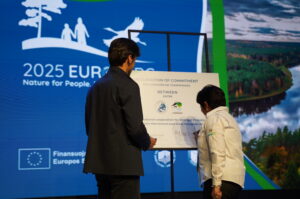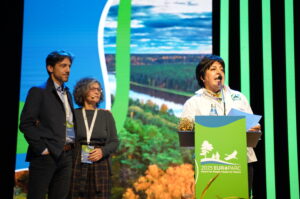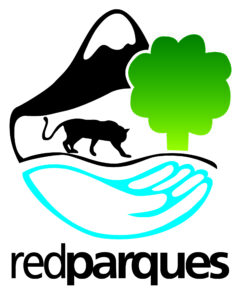From Europe to Latin America – connecting Protected Areas
Photo credit: Vaidas Garla
On Wednesday 8th of October EUROPARC Federation reached out over the Atlantic Ocean to shake a hand with our sibling organisation RedParques from Latin America.
From Europe to Latin America – connecting Protected Areas

Photo credit: Vaidas Garla
At the EUROPARC Conference 2025 in Birštonas, Lithuania, EUROPARC and RedParques shook hands and signed a declaration of commitment which aims to connect Protected Areas across oceans.
The delegation from RedParques was headed by the current Regional Coordinator, Ms. Hilda Ángel, who is also the General Manager of National Parks and Natural Monuments of the National Institute of Parks (INPARQUES) of Venezuela. Ms. Dayana Porras, the Technical Focal Point for the Regional Cooperation of RedParques and Specialist in INPARQUES participated in the delegation along with Mr. Edgar Vicuña, Deputy Director of Strategic Information and Research of the National Service of Natural Protected Areas (SERNANP) of Peru. The delegation also included Mr. Pietro Graziani, Regional Technical Coordinator of the Italian Development Cooperation Agency (AICS) of the programme AMAZONÍA+.
In the declaration of commitment, EUROPARC and RedParques agreed to formalise the collaboration with preparation of a Memorandum of Understanding and accompanying work plan. This is a logical step as both organisations work on strengthening the management of Protected Areas, and share common objectives for biodiversity conservation, sustainable development and capacity building.

Photo credit: Vaidas Garla
The themes for collaboration include:
- Capacity development and knowledge management.
- Communication, awareness-raising, and public participation.
- Policy dialogue and international cooperation.
The joint activities could include exchange of information, methodologies, and good practices through e.g. organisation of workshops and technical meetings. In effect, the organisations have already hosted several workshops together, with EUROPARC Spain taking a lead role.
EUROPARC is looking forward to exploring the possibilities of this cooperation.
Quote from Hilda Ángel:
We are convinced that, though we are two continents geographically apart, we are very similar because we both have one common goal which is the conservation of Protected Areas.

More about RedParques
RedParques is a regional network of technical cooperation among the countries of Latin America and the Caribbean, aimed at strengthening Protected Areas, biodiversity conservation, and sustainable development. Participating 23 countries seek to share lessons learned and good management practices to scale up the impact of Protected Areas in the region.
25 Years of the Council of Europe Landscape Convention
On 27 and 28 October 2025, EUROPARC joined ministers, landscape experts and partners from across Europe in Florence, Italy, to celebrate the 25ᵗʰ Anniversary of the Council of Europe Landscape Convention. The event was organised by the Council of Europe and the Italian Ministry of Culture, marking a quarter-century of work to recognise, protect, and care for Europe’s landscapes.
Aims of the Landscape Convention
Since it was first signed in Florence in 2000, the Landscape Convention, formerly known as the European Landscape Convention, has inspired countries across Europe to see all landscapes as vital parts of people’s quality of life and cultural identity. Over the years, it has encouraged communities and governments to work together to plan and manage their landscapes in sustainable and inclusive ways. To date, it is ratified by 40 Member States. The Convention is based on the assumption that landscape is a key element, an essential component of human beings’ surroundings, and an important part of their quality of life. It thus helps to strengthen the link between human rights and the environment with a view to their mutual protection and enhancement.
About the event
During the meeting, the work relating to the recommendations of the Committee of Ministers on “Landscape, a living environment”, on “Landscape and health” and on “Water resources under stress” were illustrated. Furthermore, the guidelines for action in the coming year were discussed, and one of the main topics was environmental protection to combat the triple global crisis of pollution, climate change and biodiversity loss. The discussions were guided by the Reykjavík Declaration (2023) and the Council of Europe’s new Strategy on the Environment (2025 – 2030), both of which underline the importance of landscapes in tackling pollution, climate change, and biodiversity loss.
EUROPARC was represented at the event by Council member Lidia Bai, who joined the discussions on the future of landscape governance and the essential role that Protected Areas play in shaping sustainable landscapes across Europe. She states:
It is clear that the Landscape Convention, on the basis of the Reykjavik Declaration, is focusing its attention on many issues that are at the heart of the EUROPARC Federation’s action: climate change mitigation, sustainable development, biodiversity protection, among others. It is important that many different organisations in Europe are working concretely on these issues and it is important that increasingly closer cooperation can be developed in the future.
At the conclusion of the October 28 meeting, the Conference produced a statement Declaration to be adopted by the Ministers and other State representatives. This Declaration will outline a strategic vision to strengthen multilateral cooperation and promote the effective implementation of the Convention and its integration into national policies.
EUROPARC’s Members continue to play a key role in turning the values of the Landscape Convention into real action on the ground. Especially, EUROPARC’s Taskforce for Nature Regional Landscape Parks are a driving force in:
- Applying good practices and practical tools for sustainable landscape management
- Strengthening the voice of landscape parks at the European level
- Supporting policy integration between nature, culture, and community development
- Encouraging collaboration between people and places to ensure that landscapes remain vibrant and resilient
John Watkins, Chief Executive at the National Landscape Association in the UK and an active member of EUROPARC’s Nature Regional Landscape Parks Taskforce, states:
The mission of Landscape and Regional Parks takes inspiration from, and puts into practice, the Convention’s definition of landscape: ‘an area, as perceived by people, whose character is the result of the action and interaction of natural and/or human factors. Across Europe, these places are an ongoing celebration of the bond between people and place, and this relationship is critical to tackling loss of nature and the effects of climate change.
Not only the Nature Regional Landscape Parks, but the whole EUROPARC family, aim to bridge policy and practice with their work— ensuring that the spirit of the Landscape Convention continues to thrive across Europe.
IUCN re-elects Sonia Castañeda as Regional Councillor for Western Europe
IUCN elections 2025, photo by IUCN
The International Union for Conservation of Nature (IUCN) has announced the re-election of Sonia Castañeda as Regional Councillor for Western Europe, a result that enjoyed broad and solid support from members worldwide.
The IUCN Council is the main governing body of IUCN between the sessions of the IUCN World Conservation Congress, the greatest event of its kind for nature conservation experts worldwide, and the General Assembly of its Members.
The October 2025 elections, in which the Union’s members voted, resulted in the re-election of Ms. Razan Al Mubarak of the United Arab Emirates to the Presidency. Sonia Castañeda, Deputy Director of the Biodiversity Foundation of the Spanish Ministry for Ecological Transition and the Demographic Challenge (MITECO), was also re-elected. Her candidacy, presented by the ministry, was supported by, among others, the EUROPARC Federation.
In the organization’s 78 years of existence, only three Spanish nationals have been elected to the Council. Currently, the new Council boasts more than 50% women (the highest in the Union’s history).
Sonia Castañeda: “Being a member of the IUCN Council involves making decisions during the four years between Congresses and Assemblies. Issues related to policies and projects, the organization’s governance, and financial and budgetary matters are addressed. I think it’s important that the Western European region is represented by people from the Mediterranean and, in the case of Spain, also from the Atlantic. This allows all perspectives and realities to be considered in a Council of such an international nature.”
Latest Transboundary Certification Winners
Photo: Vaidas Garla
The fact that our work is appreciated internationally is really great and shows us that we are going in the right direction in caring for the Šumava National Park.
Says Pavel Hubený, Director of the Šumava National Park Administration, and one of the winners of the 2025-2030 Transboundary Parks Award.
With this article, we welcome the transboundary areas, which have been recertified under the 2025 – 2030 Transboundary Parks certification scheme. Importantly, all three recertified protected areas achieved all 14 out of 14 Basic Standards of cooperation under the EUROPARC Transboundary Parks Programme, setting a benchmark for excellence worldwide.
Newly Certified Transboundary Protected Areas (2025-2030)
We are proud to present the Transboundary Protected Areas that have successfully earned re-certification under the Transboundary Parks Programme for 2025-2030:
🏆 Julian Alps Biosphere Reserve
A stunning landscape spanning Slovenia and Italy, the Julian Alps Biosphere Reserve has shown exceptional commitment to cross-border conservation and sustainable community engagement.
Learn more: Julian Alps story

Julian Alps Transboundary Area collecting their certificates and trophies during EUROPARC 2025 Conference. Photo: Vaidas Garla
🏆 Pasvik – Inari Transboundary Area
Stretching across Norway, Finland, and Russia, the Pasvik – Inari area is a model of cooperative management in remote and ecologically sensitive regions.
Watch the re-evaluation visit: Pasvik – Inari video

Pasvik-Inari Transboundary Area collecting their certificates and trophies during EUROPARC 2025 Conference. Photo: Vaidas Garla
🏆 Bavarian Forest & Šumava National Parks
These iconic parks on the German-Czech border have exemplified long-term collaboration, combining biodiversity conservation with sustainable tourism.
Discover their success: More on Bavarian Forest & Šumava

Martin Stary collecting certificates and trophies during EUROPARC 2025 Conference for Sumava National Park and Bavarian Forest National Park cross-border area. Photo: Vaidas Garla
Congratulations to All Teams
The achievements of these Transboundary Protected Areas are not just individual accomplishments. They reflect the combined effort of entire teams working across borders, demonstrating what is possible when collaboration and commitment come first.
Your work strengthens European cooperation, conserves nature, and sets a shining example for future generations. Keep up the excellent work!